Coastal Forests and Groundwater: Using Case Studies to Understand the Effects of Drivers and Stressors for Resource Management
Abstract
:1. Introduction
- What is the flooding threshold that influences the upland-wetland boundary, commonly defined in the coastal plain as marked by pine stands and bottomland hardwood species?
- Is the main factor the maximum ponding depth or the average length of the seasonal flooding, and alternatively, what could be the covariance if both factors are important?
- How will forest management practices such as the restoration of longleaf pine (P. palustris) insavanna habitats affect the water table dynamics and the water balance in this region?
2. The Role of Groundwater as a Driver on Forest Conditions
3. Foreseeable Pressures and Stressors on Coastal Forests
3.1. Groundwater Extraction
3.2. Geologic Materials Extraction
3.3. Paleoenvironmental Information Loss
4. Future Research Considerations
5. Summary
Acknowledgments
Author Contributions
Conflicts of Interest
Appendix
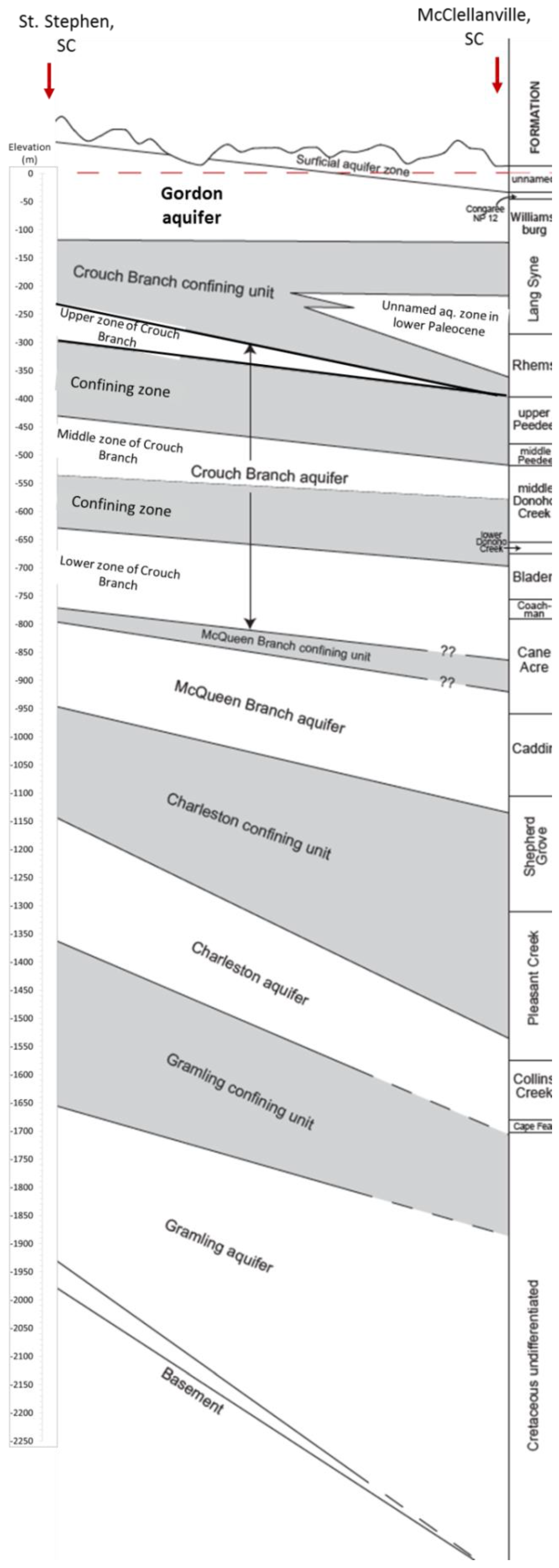
References
- Wilson, E.O. Half Earth: Our Planet’s Fight for Life; W.W. Norton and Co.: New York, NY, USA, 2016; ISBN 978-1631490828. 272p. [Google Scholar]
- Nix, S. Maps of the World’s Forests: World Forest Cover Type Maps and Natural Tree Ranges. About Education. 2016. Available online: http://forestry.about.com/od/forestresources/tp/world_Forest_Cover.htm (accessed on 22 November 2016).
- Williams, T.M.; Amatya, D.M.; Bren, L.; deJong, C.; Nettles, J.E. Future directions in forest hydrology. In Forest Hydrology: Processes, Management, and Applications; Amatya, D., Williams, T., Bren, L., de Jong, C., Eds.; CABI Publishers: Wallingford, UK, 2016; pp. 270–279. [Google Scholar]
- Harris, N. Global Forest Watch Climate: Summary of Methods and Data; World Resources Institute: Washington, DC, USA, 2016; Available online: http://www.wri.org/publication/gfw-climate-methods-data (accessed on 20 November 2016).
- Caldwell, P.; Muldoon, C.; Miniat, C.F.; Cohen, E.; Krieger, S.; Sun, G.; McNulty, S.; Bolstad, P.V. Quantifying the Role of National Forest System Lands in Providing Surface Drinking Water Supply for the Southern United States. Available online: https://www.srs.fs.usda.gov/pubs/47706 (accessed on 27 February 2017).
- National Oceanic and Atmospheric Administration. National Coastal Population Report: Population Trends from 1970 to 2020. Available online: http://stateofthecoast.noaa.gov (accessed on 18 November 2016).
- Town of Mount Pleasant. 2016 Demographics Report. Town of Mount Pleasant Department of Planning and Development. Available online: http://www.tompsc.com/DocumentCenter/View/17486 (accessed on 18 November 2016).
- United States Department of Agriculture (USDA) Forest Service. Francis Marion National Forest Plan Revision Environmental Impact Statement; USDA Forest Service, Sumter and Francis Marion National Forests: Columbia, SC, USA, 2015.
- USDA Forest Service. Francis Marion National Forest: Draft Forest Plan Assessment, 2.2: Air, Soil, and Water Resources and Quality; USDA Forest Service: Columbia, SC, USA, 2013.
- USDA—Natural Resources Conservation Service (NRCS). Soil Taxonomy: A Basic System of Soil Classification for Making and Interpreting Soil Surveys; U.S. Government Printing Office: Washington, DC, USA, 1999; 869p.
- Dahl, T. Wetland Losses in the United States: 1780s to 1980s; U.S. Department of the Interior, Fish and Wildlife Service: Washington, DC, USA, 1990; 13p.
- McCauley, L.; Jenkins, D.; Quintana-Ascencio, P. Isolated wetland loss and degradation over two decades in an increasingly urbanized landscape. Wetlands 2013, 33, 117–127. [Google Scholar] [CrossRef]
- Reice, S. Nature in Fragments: the Legacy of Sprawl; Johnson, E.A., Klemens, M.W., Eds.; Columbia University Press: New York, NY, USA, 2005; 400p. [Google Scholar]
- Mitsch, W.; Gosselink, J. Wetlands, 3rd Ed. ed; Wiley, Inc.: New York, NY, USA, 2000. [Google Scholar]
- Wilkinson, C.; Sudara, S.; Chou, L. Mangrove forests. In Proceedings of the Third ASEAN-Australia Symposium on Living Coastal Resources, Bangkok, Thailand, 16–20 May 1994; Australian Institute of Marine Science: Townsville, Queensland, Australia, 1994. [Google Scholar]
- Krieger, D.J. The Economic Value of Forest Ecosystem Services: A Review; The Wilderness Society: Washington, DC, USA, 2001; 40p. [Google Scholar]
- Hester, A. Establishing the Francis Marion: National forest history in South Carolina’s Lowcountry, 1901–1936. Available online: http://www.foresthistory.org/Publications/FHT/FHTSpringFall2011/Francis_Marion.pdf (accessed on 27 February 2017).
- USDA Forest Service. Groundwater-Dependent Ecosystems Level I: Inventory Field Guide—Inventory Methods for Assessment and Planning; USDA Forest Service: Washington, DC, USA, 2012; 191p.
- USDA Forest Service. Groundwater-Dependent Ecosystems: Level II Inventory Field Guide—Inventory Methods for Project Design and Analysis; USDA Forest Service: Washington, DC, USA, 2012; 124p.
- Howard, J.; Merrifield, M. Mapping Groundwater Dependent Ecosystems in California. PLoS ONE 2010, 5, e11249. [Google Scholar] [CrossRef] [PubMed]
- Laio, F.; Tamea, S.; Ridolfi, L.; D’Odorico, P.; Rodriguez-Iturbe, I. Ecohydrology of groundwater-dependent ecosystems: 1. stochastic water table dynamics. Water Resour. Res. 2009, 45, W05419. [Google Scholar] [CrossRef]
- Tamea, S.; Laio, F.; Ridolfi, L.; D’Odorico, P.; Rodriguez-Iturbe, I. Ecohydrology of groundwater-dependent ecosystems: 2. stochastic soil moisture dynamics. Water Resour. Res. 2009, 45, W05420. [Google Scholar] [CrossRef]
- Williams, T.; Krauss, K.; Okruszko, T. Hydrology of flooded and wetland forests. In Forest Hydrology: Processes, Management, and Applications; Amatya, D., Williams, T., Bren, L., de Jong, C., Eds.; CABI Publishers: Wallingford, UK, 2016; pp. 103–123. [Google Scholar]
- Luo, W. Quantifying groundwater-sapping landforms with a hypsometric technique. J. Geophys. Res.-Planets 2000, 105, 1685–1694. [Google Scholar] [CrossRef]
- Callahan, T.J.; Vulava, V.M.; Passarello, M.C.; Garrett, C.G. Estimating groundwater recharge in lowland watersheds. Hydrol. Proc. 2012, 26, 2845–2855. [Google Scholar] [CrossRef]
- Amatya, D.; Callahan, T.; Hansen, W.; Trettin, C.; Radecki-Pawlik, A.; Meire, P. Turkey Creek—A case study of ecohydrology and integrated watershed management in the low-gradient Atlantic Coastal Plain, USA. J. Water Resour. Prot. 2015, 7, 792–814. [Google Scholar] [CrossRef]
- Pleva, T.; Hansen, W. Current Status of Water Quality Information on the Francis Marion National Forest; USDA Forest Service Francis Marion and Sumter National Forests: Columbia, SC, USA, 2003; 43p.
- Amatya, D.M.; Callahan, T.J.; Trettin, C.C. Synthesis of 10 years of studies on Turkey Creek Watershed. In Headwaters to Estuaries: Advances in Watershed Science and Management; Stringer, C.E., Krauss, K.W., Latimer, J.S., Eds.; USDA-Forest Service: Asheville, NC, USA, 2016. [Google Scholar]
- Dai, Z.; Trettin, C.C.; Amatya, D.M. Effects of Climate Variability on Forest Hydrology and Carbon Sequestration on the Santee Experimental Forest in Coastal South Carolina; U.S. Department of Agriculture Forest Service Southern Research Station: Asheville, SC, USA, 2013; 44p.
- Edwards, L.E.; Gohn, G.S.; Self-Trail, J.M.; Prowell, D.C.; Bybell, L.M.; Bardot, L.P.; Firth, J.V.; Huber, B.T.; Frederiksen, N.O.; MacLeod, K.G. Physical Stratigraphy, Paleontology, and Magnetostratigraphy of the USGS—Santee Coastal Reserve Core (CHN-803), Charleston County, South Carolina; U.S. Department of the Interior: Washington, DC, USA, 1999; 66p.
- Campbell, B.; Coes, A. Groundwater Availability in the Atlantic Coastal Plain of North and South Carolina; U.S. Department of the Interior: Washington, DC, USA, 2010; 242p.
- Dean, J.; Camporese, M.; Webb, J.; Grover, S.; Dresel, P.; Daly, E. Water balance complexities in ephemeral catchments with different land uses: Insights from monitoring and distributed hydrologic modeling. Water Resour. Res. 2016, 52, 4713–4729. [Google Scholar] [CrossRef]
- Dean, J.; Webb, J.; Jacobsen, G.; Chisari, R.; Dresel, P. A groundwater recharge perspective on locating tree plantations within low-rainfall catchments to limit water resource losses. Hydrol. Earth Syst. Sci. 2015, 19, 1107–1123. [Google Scholar] [CrossRef]
- Skaggs, R.W. A Water Management Model for Shallow Water Table Soils; Report No. 134; University of North Carolina, Water Resources Research Institute: Raleigh, NC, USA, 1978. [Google Scholar]
- Pyzoha, J.E.; Callahan, T.J.; Sun, G.; Trettin, C.C.; Miwa, M. A conceptual hydrologic model for a forested Carolina bay depressional wetland on the coastal plain of South Carolina, USA. Hydrol. Process. 2007, 22, 2689–2698. [Google Scholar] [CrossRef]
- Weems, R.E.; Lewis, W.C. Detailed Geologic Sections from Auger Holes in Northeastern Charleston County, South Carolina, East of 79 Degrees, 45 Minutes West Longitude; U.S. Department of the Interior: Washington, DC, USA, 1997; 84p.
- Weems, R.E.; Bybell, L.M. Geology of the Black Mingo Group (Paleocene) in the Kingstree and St. Stephen areas of South Carolina. Trans. Am. Philos. Soc. 1999, 88, 9–27. [Google Scholar] [CrossRef]
- Wachob, A.; Hockensmith, B.; Luciano, K.; Howard, C.S. Potentiometric Surface of the Floridan and Tertiary Sand Aquifers in South Carolina, November 2013; South Carolina Department of Natural Resources, Land, Water and Conservation Division: Columbia, SC, USA, 2014.
- Harder, S.V.; Amatya, D.M.; Callahan, T.J.; Trettin, C.C.; Hakkila, J. Hydrology and water budget for a forested Atlantic coastal plain watershed, South Carolina. J. Am. Water Resour. Assoc. 2007, 43, 563–575. [Google Scholar] [CrossRef]
- Henderson, J.; Grissino-Mayer, H. Climate–tree growth relationships of longleaf pine (Pinus palustris Mill.) in the southeastern coastal plain, USA. Dendrochronologia 2009, 27, 31–43. [Google Scholar] [CrossRef]
- Williams, T. Response of shallow water tables to rainfall. In Proceedings Soil Moisture and Site Productivity Symposium; Balmer, W., Ed.; U.S. Department of Agriculture Forest Service: Myrtle Beach, SC, USA, 1978; pp. 363–370. [Google Scholar]
- Amatya, D.M.; Sun, G.; Skaggs, R.W.; Trettin, C.C. Testing of DRAINMOD for forested watersheds with non-pattern drainage. In Proceedings of the ASAE Annual International Meeting, Las Vegas, NV, USA, 27–30 July 2003; Paper Number: 032046.
- Galloway, D.L.; Alley, W.M.; Barlow, P.M.; Reilly, T.E.; Tucci, P. Evolving Issues and Practices in Managing Ground-Water Resources: Case Studies on the Role of Science; U.S. Department of the Interior: Washington, DC, USA, 2003; 73p.
- Dean, J.; Webb, J.; Jacobsen, G.; Chisari, R.; Dresel, P. Biomass uptake and fire as controls on groundwater solute evolution on a southeast Australian granite: Aboriginal land management hypothesis. Biogeosciences 2014, 11, 4099–4114. [Google Scholar] [CrossRef]
- Williams, T.; Song, B.; Trettin, C.; Gresham, C. A Review of spatial aspects of forest damage and recovery on the South Carolina coast following Hurricane Hugo. J. Geogr. Nat. Disasters 2013, 3, 110. [Google Scholar]
- Marion, D.A.; Sun, G.; Caldwell, P.V.; Ford, C.R.; Ouyang, Y.; Amatya, D.M.; Clinton, B.D.; Conrads, P.A.; Gull-Laird, S.; Dai, Z.; et al. Managing forest water quantity and quality under climate change. In Climate Change Adaptation and Mitigation Management Options: A Guide for Natural Resource Managers in Southern Forest Ecosystems; Vose, J., Kleipzig, K., Eds.; CRC Press: Boca Raton, FL, USA, 2013; 496p. [Google Scholar]
- Williams, T.M.; Amatya, D.M.; Jayakaran, A.; Song, B.; Trettin, C.; Krauss, K. Runoff generation from shallow southeastern forests: Unusual behavior of paired watersheds following a major disturbance. In Proceedings of the ASABE Annual International Meeting, Dallas, TX, USA, 29 July–1 August 2012; American Society of Agricultural and Biological Engineers: Dallas, TX, USA; Paper Number: 121337045.
- Epps, T.H.; Hitchcock, D.R.; Jayakaran, A.D.; Loflin, D.R.; Williams, T.M.; Amatya, D.M. Characterization of storm flow dynamics of headwater streams in the South Carolina lower coastal plain. J. Am. Water Res. Assoc. 2012, 49, 76–89. [Google Scholar] [CrossRef]
- Amatya, D.M.; Skaggs, R.W. Long-term hydrology and water quality of a drained pine plantation in North Carolina, USA. Trans. ASABE 2011, 54, 2087–2098. [Google Scholar] [CrossRef]
- Amatya, D.; Jha, M. Evaluating the SWAT model for a low-gradient forested watershed in coastal South Carolina. Trans. ASABE 2011, 54, 2151–2163. [Google Scholar] [CrossRef]
- Dai, Z.; Trettin, C.; Li, C.; Amatya, D.; Sun, G.; Li, H. Sensitivity of stream flow and water table depth to potential climatic variability in a coastal forested watershed. J. Am. Water Resour. Assoc. 2010, 46, 1036–1048. [Google Scholar] [CrossRef]
- Danish Hydraulic Institute (DHI). MIKE SHE Technical Reference; Danish Hydraulic Institute, DHI Water and Environment: Horsholm, Denmark, 2005. [Google Scholar]
- Williams, L.J.; Kuniansky, E.L. Revised Hydrogeologic Framework of the Floridan Aquifer System in Florida and Parts of Georgia, Alabama, and South Carolina; U.S. Department of the Interior: Washington, DC, USA, 2015; 156p.
- Llamas, M.R. Conflicts between wetland conservation and groundwater exploitation: Two case histories in Spain. Environ. Geol. Water Sci. 1988, 11, 241–251. [Google Scholar] [CrossRef]
- Stewart, M.; Langevina, C. Post audit of a numerical prediction of wellfield drawdown in a semiconfined aquifer system. Ground Water 1999, 37, 245–252. [Google Scholar] [CrossRef]
- Yobbi, D.K. Testing the Sensitivity of Pumpage to Increases in Surficial Aquifer System Heads in the Cypress Creek Well-Field Area, West-Central Florida—An Optimization Technique; U.S. Department of the Interior: Washington, DC, USA, 2002; 25p.
- Park, A.D. The Ground-Water Resources of Charleston, Berkeley, and Dorchester Counties, South Carolina. Water Resources Commission; Report Number 139; South Carolina Water Resources Commission: Columbia, SC, USA, 1985; 86p. [Google Scholar]
- USDA—Natural Resources Conservation Service. Soil Survey Report of Berkeley County, South Carolina; USDA—Natural Resources Conservation Service: Washington, DC, USA, 1980; 94p.
- Hoffman, J.L. The Noordbergum Effect; New Jersey Department of Environmental Protection, Division of Water Resources: Trenton, NJ, USA, 1984; 16p. [Google Scholar]
- Ostendorf, D.W.; DeGroot, D.J.; Judge, A.I.; LaMesa, D.F. Method to characterize aquitards above leaky aquifers with water supply wells. Hydrogeol. J. 2010, 18, 595–605. [Google Scholar] [CrossRef]
- Sun, G.; Noormets, A.; Gavazzi, M.; McNulty, S.; Chen, J.; Domec, J.-C.; King, J.; Amatya, D.; Skaggs, R.W. Energy and water balances of two contrasting loblolly pine plantations on the lower coastal plain of North Carolina, USA. For. Ecol. Manag. 2010, 259, 1299–1310. [Google Scholar] [CrossRef]
- Healy, R.; Cook, P. Using groundwater levels to estimate recharge. Hydrogeol. J. 2002, 10, 91–109. [Google Scholar] [CrossRef]
- Freeze, R.; Cherry, J. Groundwater; ISBN 978-0133653120: Prentice-Hall, Inc.: Upper Saddle River, NJ, USA, 1979; 604p. [Google Scholar]
- Zhang, L.; Dawes, W.R.; Walker, G.R. Response of mean annual evapotranspiration to vegetation changes at catchment scale. Water Resour. Res. 2001, 37, 701–708. [Google Scholar] [CrossRef]
- Vose, J.M.; Martin, K.L.; Barten, P.K. Applications to forest hydrological science to watershed management in the 21st century. In Forest Hydrology: Processes, Management, and Applications; Amatya, D., Williams, T., Bren, L., de Jong, C., Eds.; CABI Publishers: Wallingford, UK, 2016; pp. 240–253. [Google Scholar]
- Senn, L.H.-R. Ecohydrology of a Floodplain Forest: Relationships between Vegetation and Groundwater Response at Congaree National Park, South Carolina, USA. Master’s Thesis, University of Charleston, South Carolina, Charleston, SC, USA, 13 December 2014. [Google Scholar]
- Morton, R.A. An Overview of Coastal Land Loss: With Emphasis on the Southeastern United States; U.S. Department of the Interior: Washington, DC, USA, 2003.
- Colquhoun, D. Terrace sediment complexes in central South Carolina. University of South Carolina Press: Columbia, SC, USA, 1965; 62p. [Google Scholar]
- South Carolina Department of Natural Resources. Geologic Hazards of the South Carolina Coastal Plain 2012. Available online: http://www.dnr.sc.gov/geology/ggms5 (accessed on 2 February 2017).
- Aucott, W.R. Hydrology of the Southeastern Coastal Plain Aquifer System in South Carolina and Parts of Georgia and North Carolina (Regional Aquifers-System Analysis Southeastern Coastal Plain); U.S. Geological Survey Professional Paper 1410-E; U.S. Geological Survey: Washington, D.C. USA, 1986; 95p.
- Knight, R.L.; Clarke, R.A.; Keller, C.H.; Knight, S.L.; Petry, C. Great Swamp natural effluent management system—A summary of thirteen years of operations. Ecol. Eng. 2014, 73, 353–366. [Google Scholar] [CrossRef]
- USDA—Natural Resources Conservation Service. Histosols. In Soil Taxonomy: A Basic System of Soil Classification for Making and Interpreting Soil Surveys, 2nd ed.; Agriculture Handbook No. 436; Natural Resources Conservation Service: Washington, DC, USA, 1999; pp. 473–487, p. 886. [Google Scholar]
- Cameron, C.C.; Force, E.R.; Gazdik, G.C.; Rodehamel, E.C. Mineral Resources of the Wambaw Swamp Wilderness Study Area, Charleston County, South Carolina; U.S. Department of the Interior: Washington, DC, USA, 1979; 35p.
- Skaggs, R.W.; Phillips, B.D.; Chescheir, G.M.; Trettin, C.C. Effects of minor drainage on hydrology of forested wetlands. Trans. ASABE 2011, 54, 2139–2149. [Google Scholar] [CrossRef]
- Cypert, E. The effects of fires in the Okefenokee Swamp in 1954 and 1955. Am. Midl. Nat. 1961, 66, 485–503. [Google Scholar] [CrossRef]
- Stone, P.A. Some origins, successions, and questions regarding marsh inliers within S.E.U.S. forested peatlands. In Proceedings of the Southern Forested Wetlands Ecology and Management Conference, Clemson, SC, USA, 25–27 March 1996.
- Shelley, D.C. Geology, Geomorphology, and Tectonics of the Congaree River Valley, South Carolina. Ph.D. Thesis, University of South Carolina, Columbia, SC, USA, 18 May 2007. [Google Scholar]
- Shelley, D.C.; Werts, S.; Dvoracek, D.; Armstrong, W. Bluff to bluff: A field guide to floodplain geology and geomorphology of the Lower Congaree River Valley, South Carolina. In From the Blue Ridge to the Coastal Plain: Field Excursions in the Southeastern United States; Eppes, M., Bartholomew, M., Eds.; Geological Society of America Field Guides: Charlotte, NC, USA, 2012; Volume 29, pp. 67–92. [Google Scholar]
- DeSteven, D.; Harrison, C.A. Hydrology, Vegetation, and Landscape Distribution of Depression Wetlands on the Francis Marion National Forest—Final Report; USDA Forest Service Southern Research Station: Washington, DC, USA, 2006; 24p.
- Winter, T.; Rosenberry, D. Hydrology of prairie pothole wetlands during drought and deluge: A 17-year study of the Cottonwood Lake wetland complex in North Dakota in the perspective of longer term measured and proxy hydrological records. Clim. Chang. 1998, 40, 189–209. [Google Scholar] [CrossRef]
- Huang, S.; Young, C.; Abdul-Aziz, O.; Dahal, D.; Feng, M.; Liu, S. Simulating the water budget of a Prairie Potholes complex from LiDAR and hydrological models in North Dakota, USA. Hydrol. Sci. J. 2013, 58, 1434–1444. [Google Scholar] [CrossRef]
- Golden, H.E.; Lane, C.R.; Amatya, D.; Bandilla, K.; Raanan-Kiperwas, H.; Ssegane, H. Modeling watershed-scale hydrologic connections between geographically isolated wetlands and surface water systems. J. Environ. Model. Softw. 2014, 53, 190–206. [Google Scholar] [CrossRef]
- Rains, M.C.; Leibowitz, S.G.; Cohen, M.J.; Creed, I.F.; Golden, H.E.; Jawitz, J.W.; Kalla, P.; Lane, C.R.; Lang, M.W.; McLaughlin, D.L. Geographically isolated wetlands are part of the hydrological landscape. Hydrol. Process. 2015, 30, 153–160. [Google Scholar] [CrossRef]
- McKown, M.R. A wetland by any other name: Where does federal jurisdiction apply? GPSolo 2016, 33, 48–53. [Google Scholar]
- Gonzales-Benecke, C.A.; Martin, T.A.; Cropper, W.P., Jr. Whole-tree water relations of co-occurring mature Pinus palustris and Pinus elliottii var. elliottii. Can. J. For. Res. 2010, 41, 509–523. [Google Scholar] [CrossRef]
- Viner, B.; Parker, M.; Maze, G.; Varnedoe, P.; Leclerc, M.; Starr, G.; Aubrey, D.; Zhang, G.; Duarte, H. Intermediate time scale response of atmospheric CO2 following prescribed fire in a longleaf pine forest. J. Geophys. Res. Biogeosci. 2016, 121, 2745–2760. [Google Scholar] [CrossRef]
- Bacchus, S.T. Potential for reduced infiltration and recharge on a local scale following cover type conversions in the southeastern coastal plain. In Proceedings of the 1995 Georgia Water Resources Conference, The University of Georgia, Athens, GA, 11–12 April 1995; Hatcher, K.J., Ed.; Vinson Institute of Government: Athens, GA, USA, 1995. [Google Scholar]
- Whelan, A.; Starr, G.; Staudhammer, C.L.; Loescher, H.W.; Mitchell, R.J. Effects of drought and prescribed fire on energy exchange in longleaf pine ecosystems. Ecosphere 2015, 6, 128. [Google Scholar] [CrossRef]
- Jayakaran, A.; Williams, T.M.; Ssegane, H.S.; Amatya, D.M.; Song, B.; Trettin, C. Hurricane impacts on a pair of coastal forested watersheds: Implications of selective hurricane damage to forest structure and streamflow dynamics. Hydrol. Earth Syst. Sci. 2014, 18, 1151–1164. [Google Scholar] [CrossRef]
- Arkema, K.; Guannel, G.; Verutes, G.; Wood, S.; Guerry, A.; Ruckelshaus, M.; Kareiva, P.; Lacayo, M.; Silver, J. Coastal habitats shield people and property from sea-level rise and storms. Nat. Clim. Chang. 2013, 3, 913–918. [Google Scholar] [CrossRef]
- Saha, A.; Saha, S.; Sadle, J.; Jiang, J.; Ross, M.; Price, R.; Sternberg, L.; Wendelberger, K. Sea level rise and South Florida coastal forests. Clim. Chang. 2011, 107, 81–108. [Google Scholar] [CrossRef]
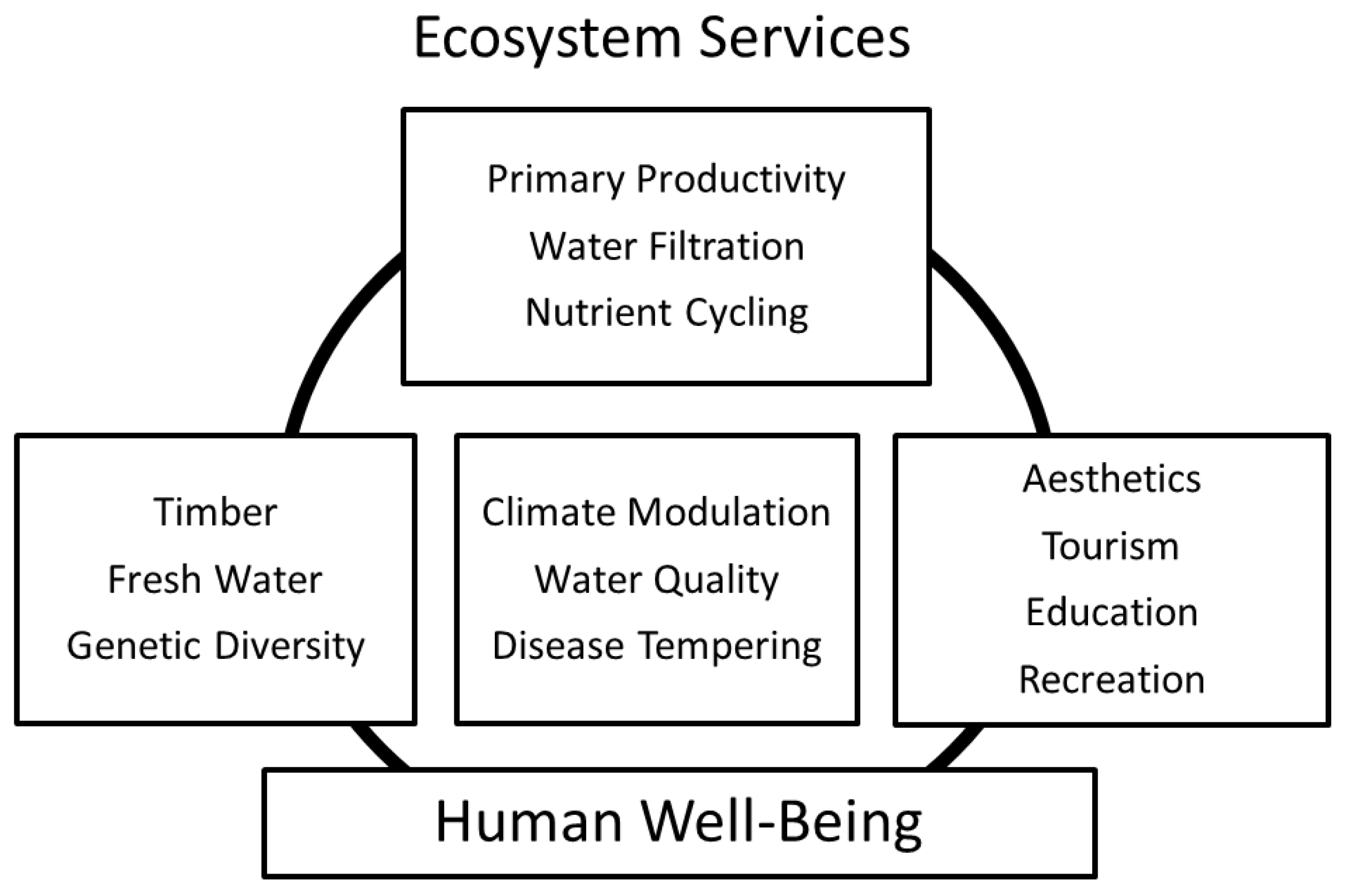
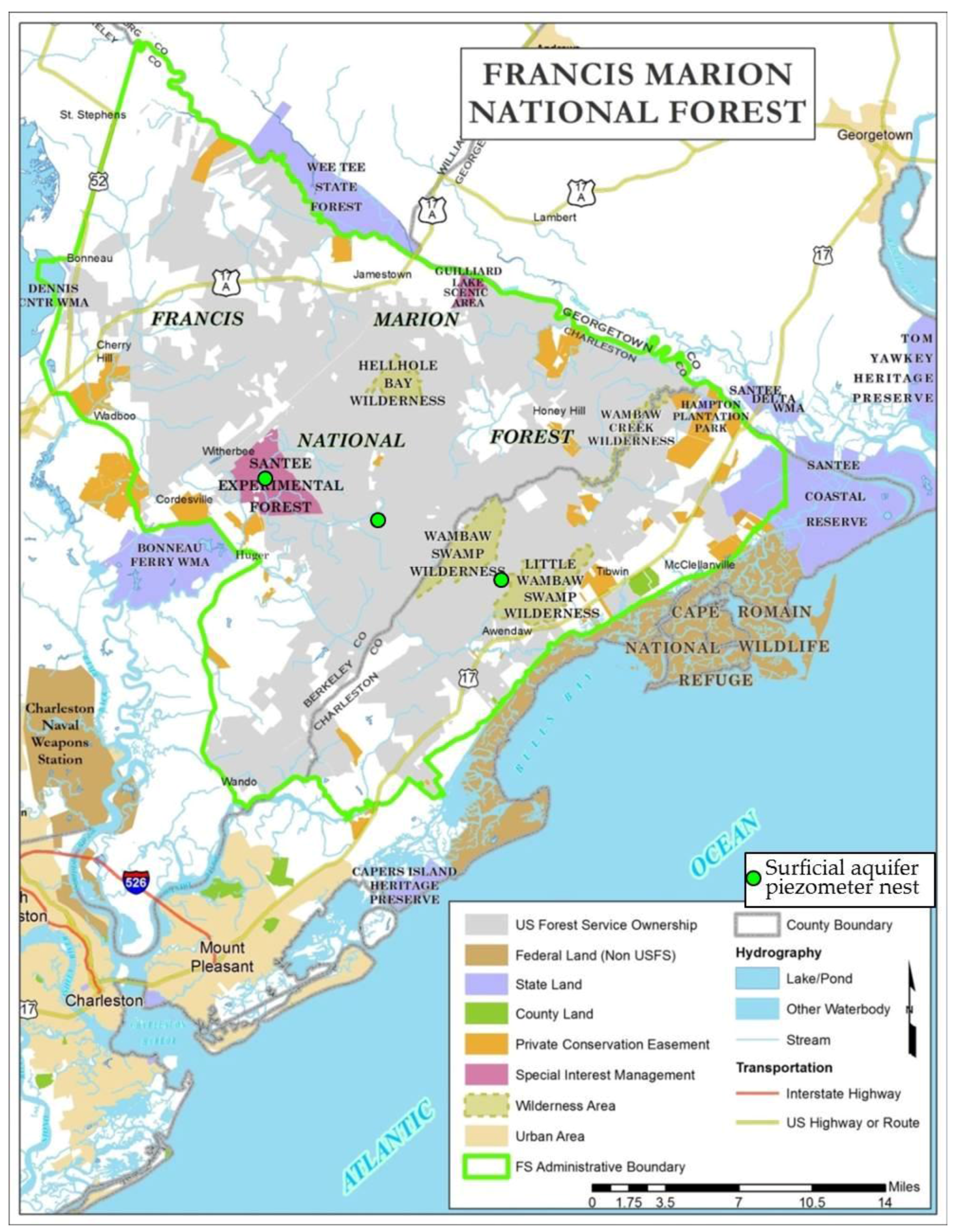
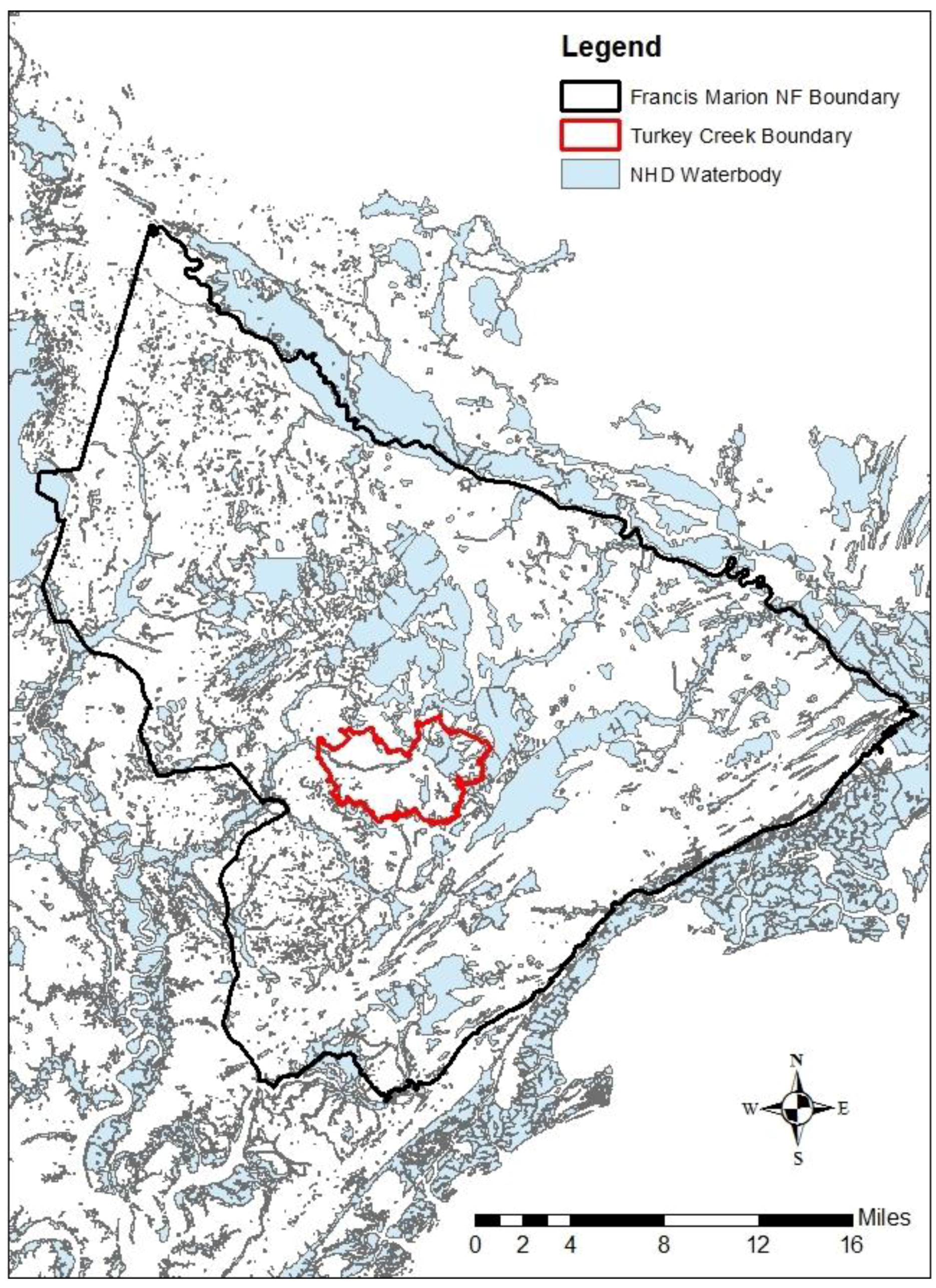
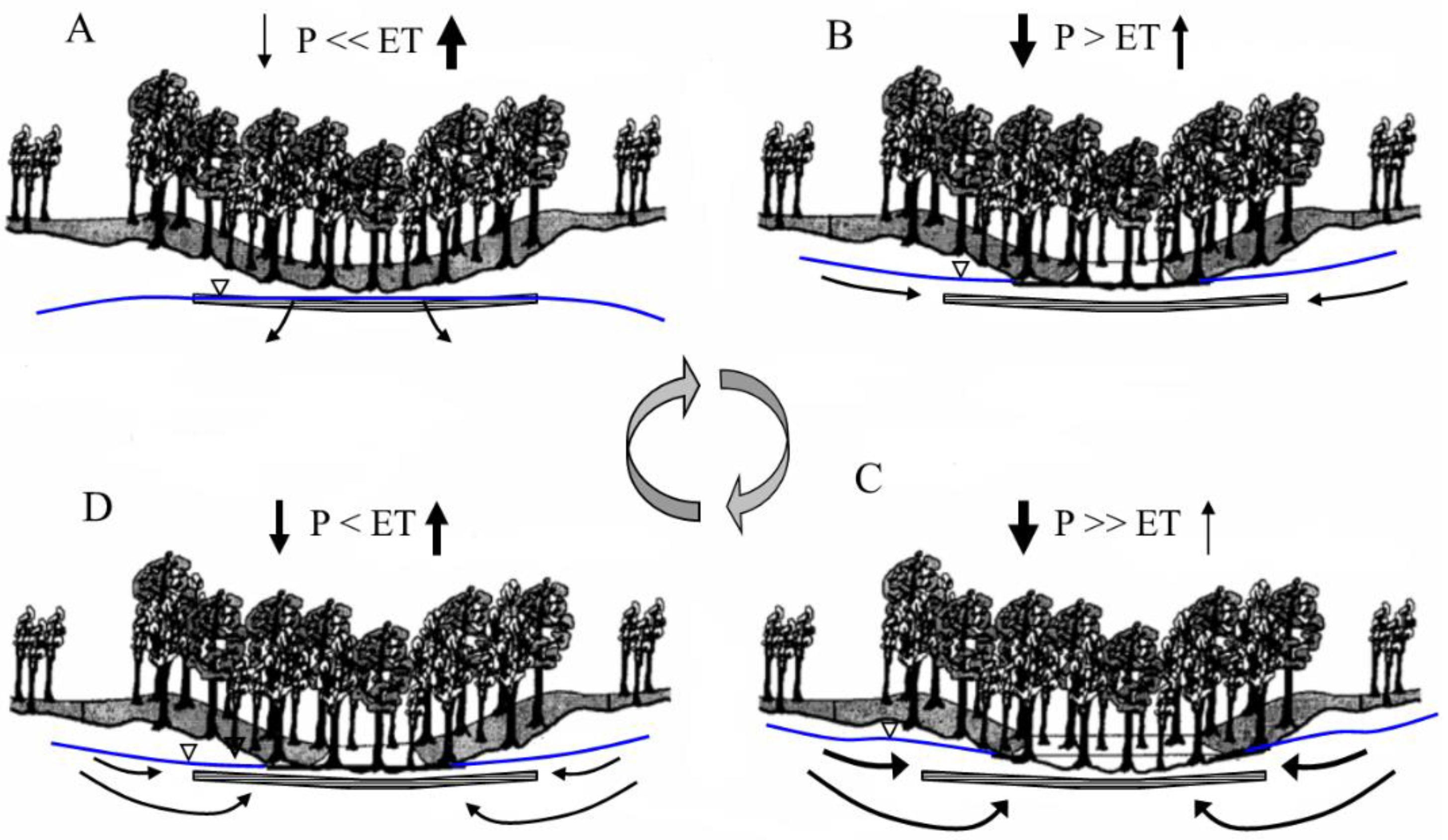
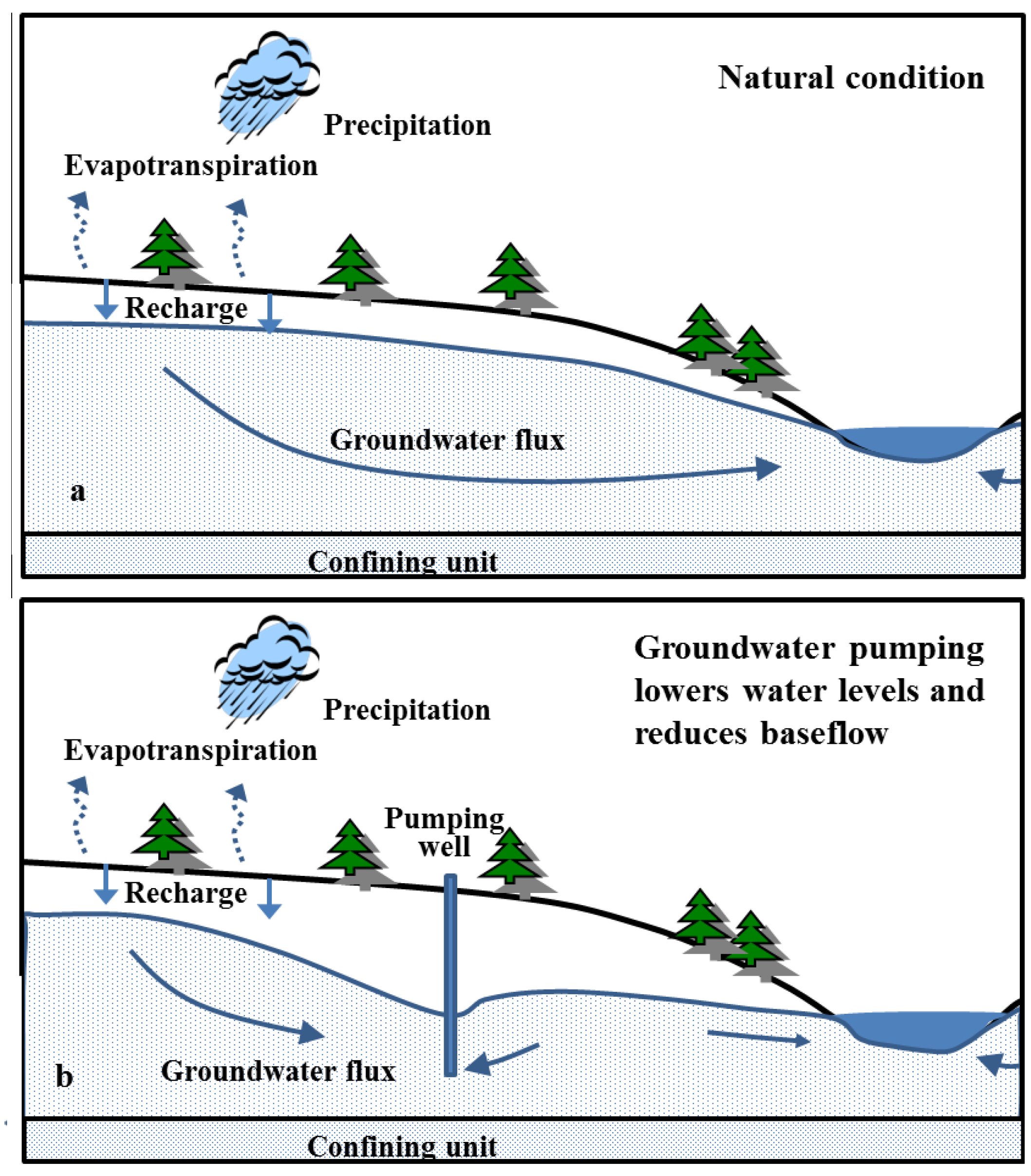
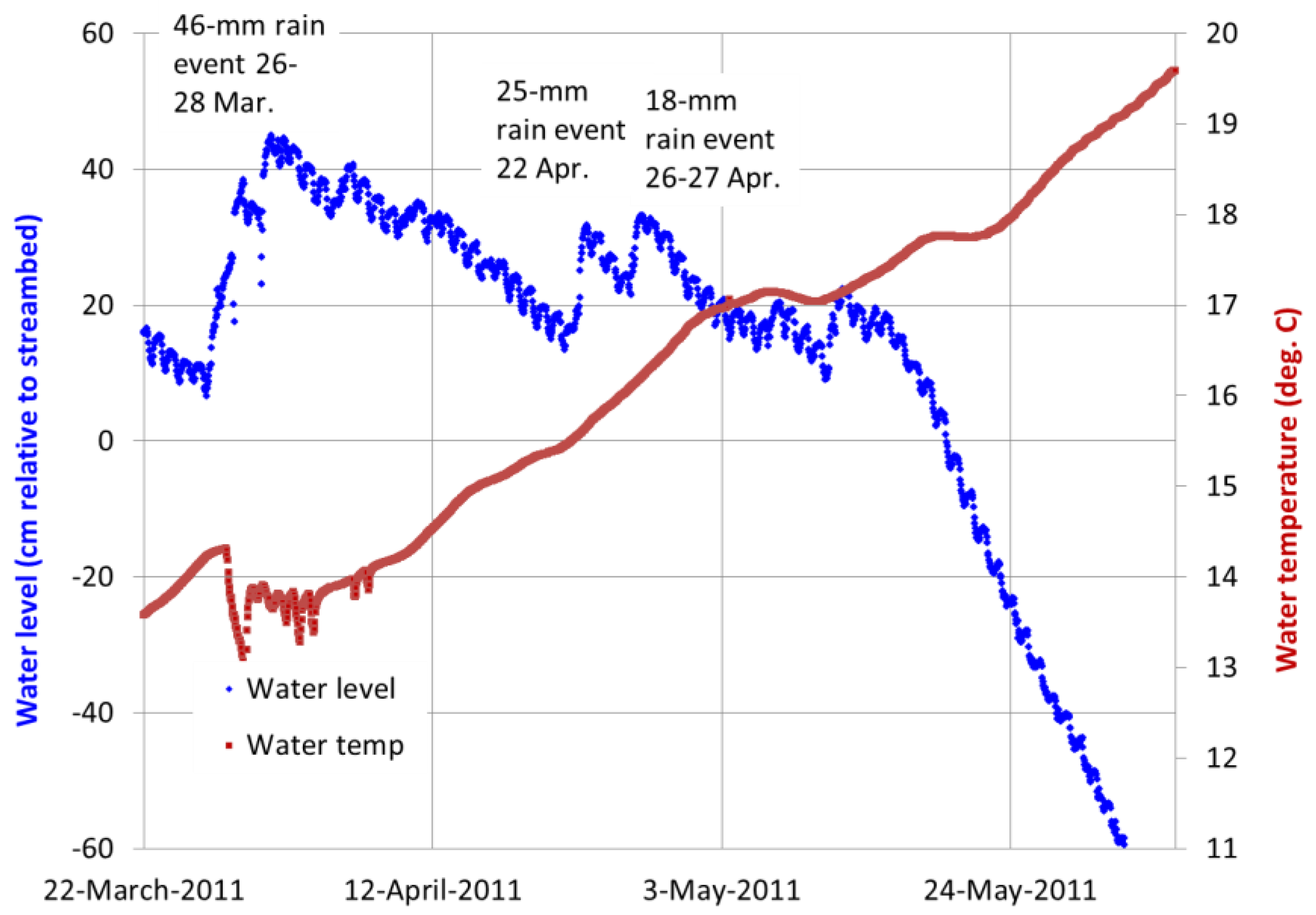
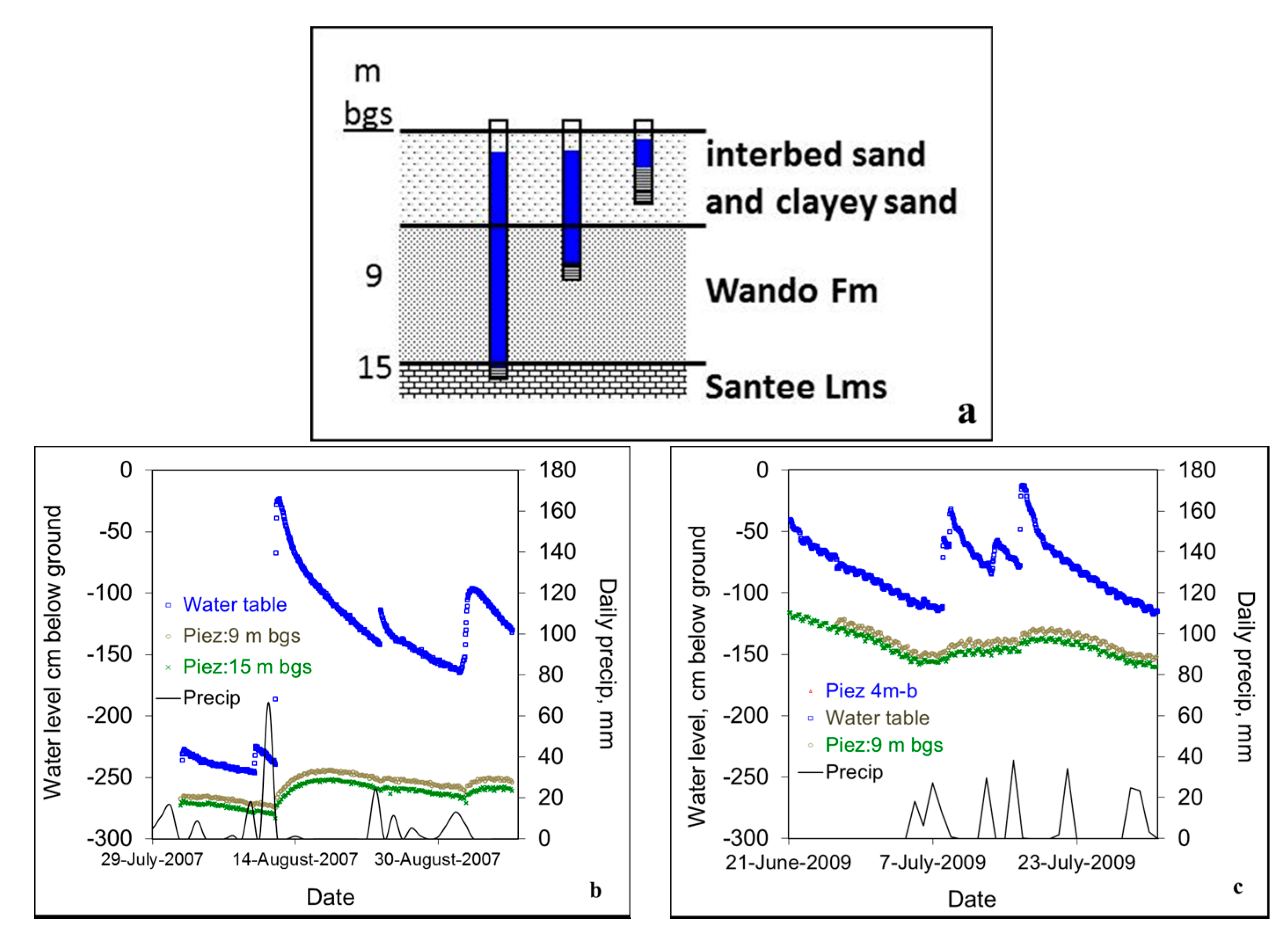
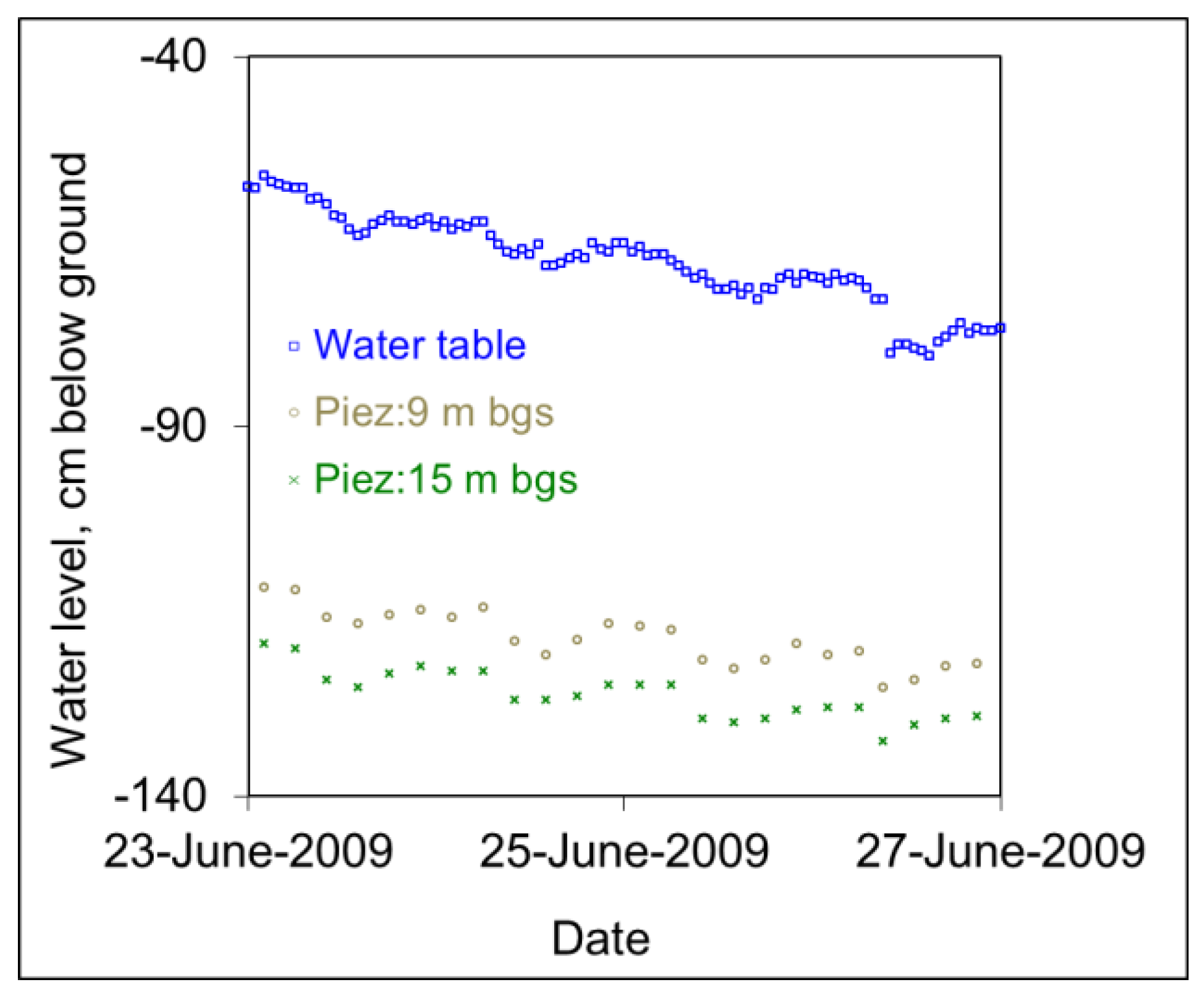
© 2017 by the authors. Licensee MDPI, Basel, Switzerland. This article is an open access article distributed under the terms and conditions of the Creative Commons Attribution (CC BY) license ( http://creativecommons.org/licenses/by/4.0/).
Share and Cite
Callahan, T.J.; Amatya, D.M.; Stone, P.A. Coastal Forests and Groundwater: Using Case Studies to Understand the Effects of Drivers and Stressors for Resource Management. Sustainability 2017, 9, 447. https://doi.org/10.3390/su9030447
Callahan TJ, Amatya DM, Stone PA. Coastal Forests and Groundwater: Using Case Studies to Understand the Effects of Drivers and Stressors for Resource Management. Sustainability. 2017; 9(3):447. https://doi.org/10.3390/su9030447
Chicago/Turabian StyleCallahan, Timothy J., Devendra M. Amatya, and Peter A. Stone. 2017. "Coastal Forests and Groundwater: Using Case Studies to Understand the Effects of Drivers and Stressors for Resource Management" Sustainability 9, no. 3: 447. https://doi.org/10.3390/su9030447




